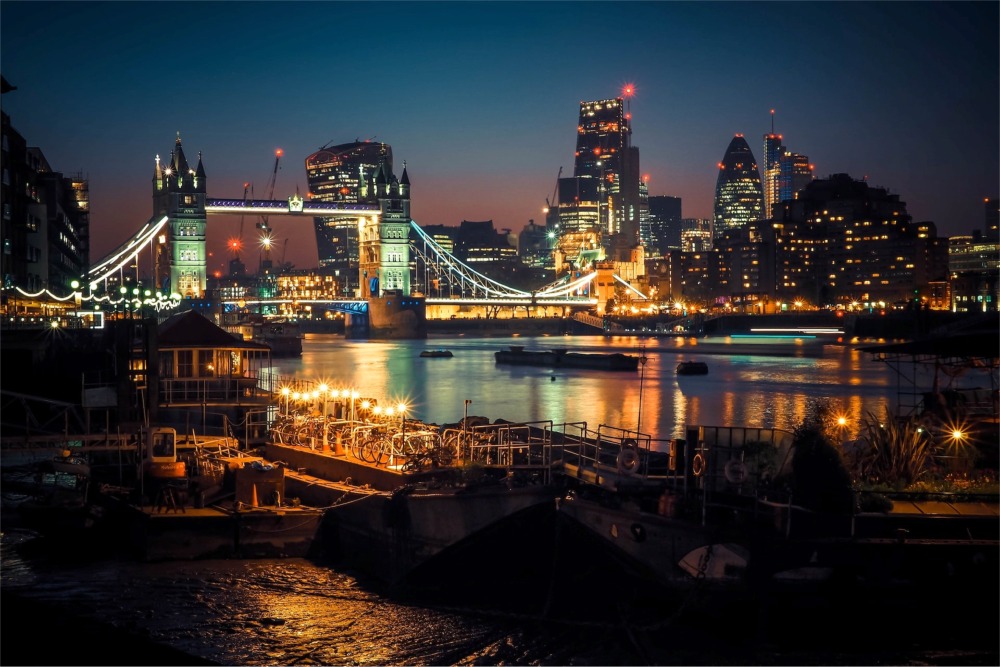Tower Bridge Cityscape
Home > Photos from England > London Gallery 1 > Tower Bridge from Downings Roads Moorings

The night was a canvas of stars, the sky a rich indigo. The air was crisp, but not cold, as if the city was holding its breath. The stirring of wind over the waters brought a sense of life, an invitation to explore the beauty of the night.
With each step, the view of the river seemed to open up, from the intricate details of the Tower Bridge to the glittering lights of the city. Even the hum of distant traffic was strangely soothing, a gentle reminder of the life that existed beyond the bridge.
The soothing lull of the Thames River provided the perfect backdrop for this picture. At the centre of the photo is the majestic Tower Bridge, with its two towers standing vigil like sentries against the night. In the background, 30 St. Mary Axe's imposing glass facade stood like an ever-watchful guardian of the city.
With a steady hand and a keen eye, the photographer clicked the shutter of his camera, capturing the beauty of the night in a single frame. It was a moment he knew he would never forget.
Downings Roads Moorings
Downings Roads Moorings is a mooring for barges on the River Thames near Tower Bridge that is home to a small community of houseboat dwellers in Central London. In 2003 and 2004, they were threatened with eviction by Southwark Council. The members of the community appealed. The then Mayor of London Ken Livingstone commented in a letter to Southwark Council that "The principle of retaining the moorings is supported by the London Plan policy 4C.19 and supporting text contained in paragraphs 4.117 and 4.118. The mix of uses proposed for these moorings should be seen as broadly acceptable in the context of a multi-functional Blue Ribbon Network as long as there are appropriate amenity and environmental safeguards in place.". Their eviction was quashed in late 2004.
As of 2013, the walkways between the moorings have been turned into a water-borne urban garden, known as the Floating Barge Gardens or Garden Barge Square.
Tower Bridge
Tower Bridge is a Grade I listed combined bascule and suspension bridge in London, built between 1886 and 1894, designed by Horace Jones and engineered by John Wolfe Barry with the help of Henry Marc Brunel. It crosses the River Thames close to the Tower of London and is one of five London bridges owned and maintained by the Bridge House Estates, a charitable trust founded in 1282. The bridge was constructed to give better access to the East End of London, which had expanded its commercial potential in the 19th century. The bridge was opened by Edward, Prince of Wales and Alexandra, Princess of Wales in 1894.
The bridge is 800 feet (240 m) in length and consists of two 213-foot (65 m) bridge towers connected at the upper level by two horizontal walkways, and a central pair of bascules that can open to allow shipping. Originally hydraulically powered, the operating mechanism was converted to an electro-hydraulic system in 1972. The bridge is part of the A100 London Inner Ring Road and thus the boundary of the London congestion charge zone, and remains an important traffic route with 40,000 crossings every day. The bridge deck is freely accessible to both vehicles and pedestrians, whereas the bridge's twin towers, high-level walkways and Victorian engine rooms form part of the Tower Bridge Exhibition.
Tower Bridge has become a recognisable London landmark. It is sometimes confused with London Bridge, about 0.5 miles (800 m) upstream, which has led to a persistent urban legend about an American purchasing the wrong bridge.
30 St Mary Axe
St Mary Axe was a medieval parish in the City of London whose name survives as that of the street which formerly occupied it. The Church of St Mary Axe was demolished in 1561 and its parish united with that of St Andrew Undershaft, which is situated on the corner of St Mary Axe and Leadenhall Street. The site of the former church is now occupied by Fitzwilliam House, a fact acknowledged by a blue plaque on the building's façade. Nearby parishes include the medieval Great St Helen's (1210) and St Ethelburga (14th century).
The street name may derive from a combination of the church dedicated to the Virgin Mary and a neighbouring tavern that prominently displayed a sign with an image of an axe, or simply from the church name itself, which may have come from the axes used by the Worshipful Company of Skinners, who were patrons. The sign of an axe is reported to have been present over the east end of the church.
The street St Mary Axe is now most notable for the Baltic Exchange at No. 38, and the "Gherkin" at No. 30, a distinctively shaped skyscraper built on the site of the former buildings of the Baltic Exchange and the UK Chamber of Shipping (destroyed by an IRA bomb in 1992). The street originates at its northern end as a turn-off Houndsditch, with traffic flowing one-way southbound, and it originates at its southern end as a turn-off Leadenhall Street, with traffic flowing one way northbound. Both one-way portions of St Mary Axe converge at Bevis Marks, where traffic is forced westward into Camomile Street.
Number 70 St Mary Axe appears in several novels by the British author Tom Holt as the address of a firm of sorcerers headed by J. W. Wells. This is itself a reference to Gilbert and Sullivan's The Sorcerer. In the song "My Name Is John Wellington Wells", the lyric renders his address as "Number Seventy, Simmery Axe"; this reflects the fact that some Londoners pronounce the street's name as "S'M'ry Axe" rather than enunciating it fully. The Tom Holt novels and The Sorcerer were written before the current office building at 70 St Mary Axe was constructed.
From Wikipedia, the free encyclopedia.


